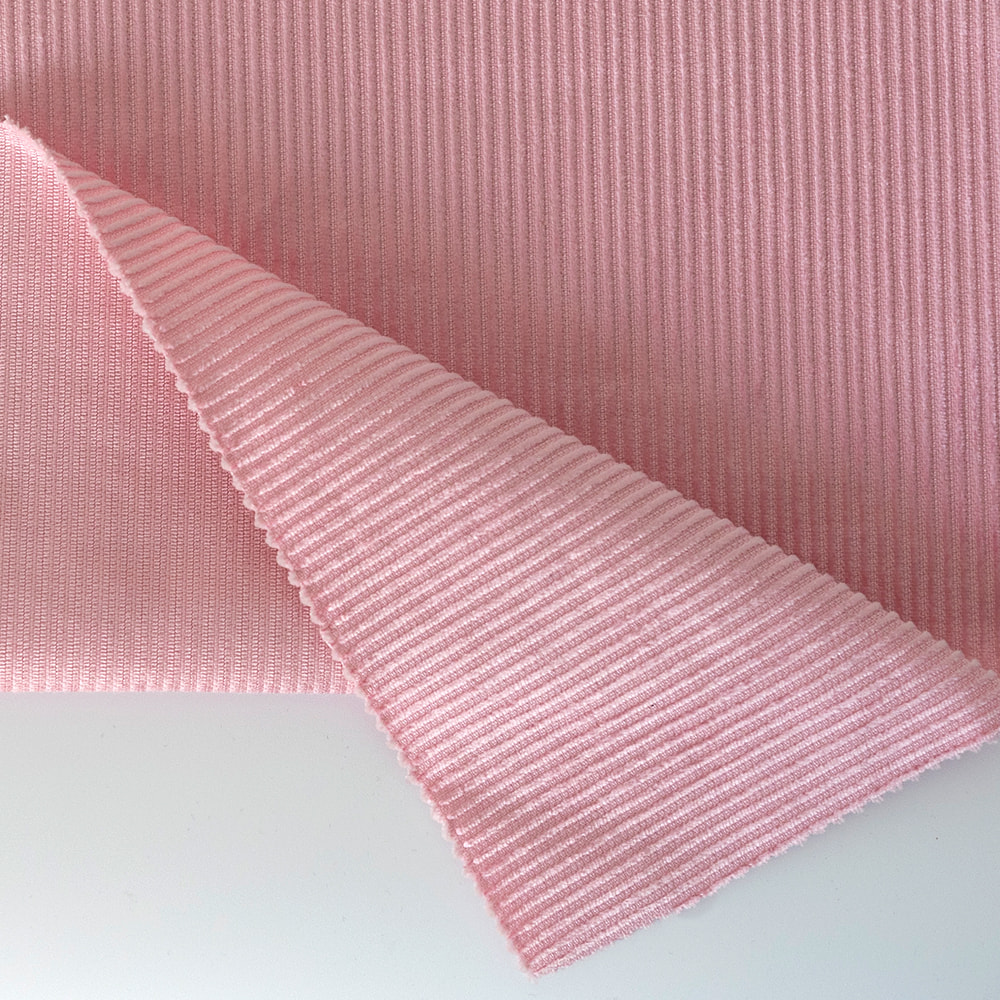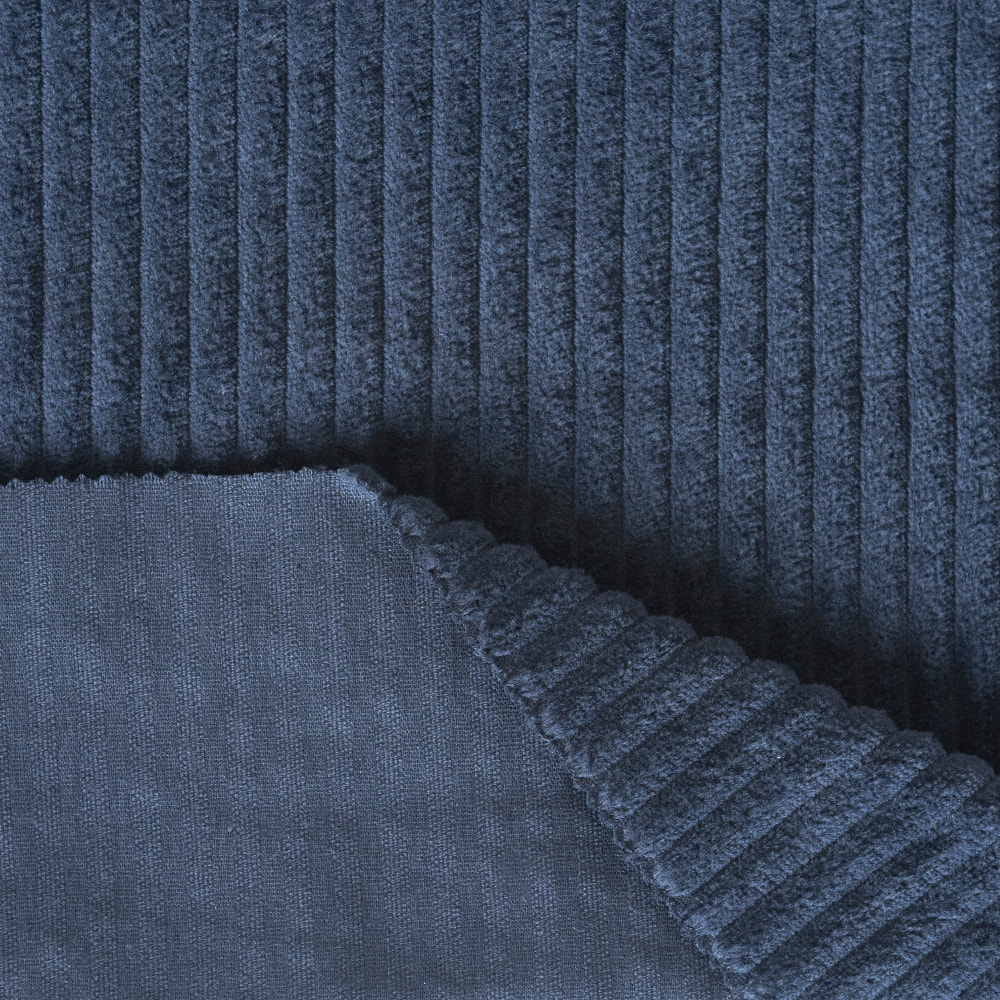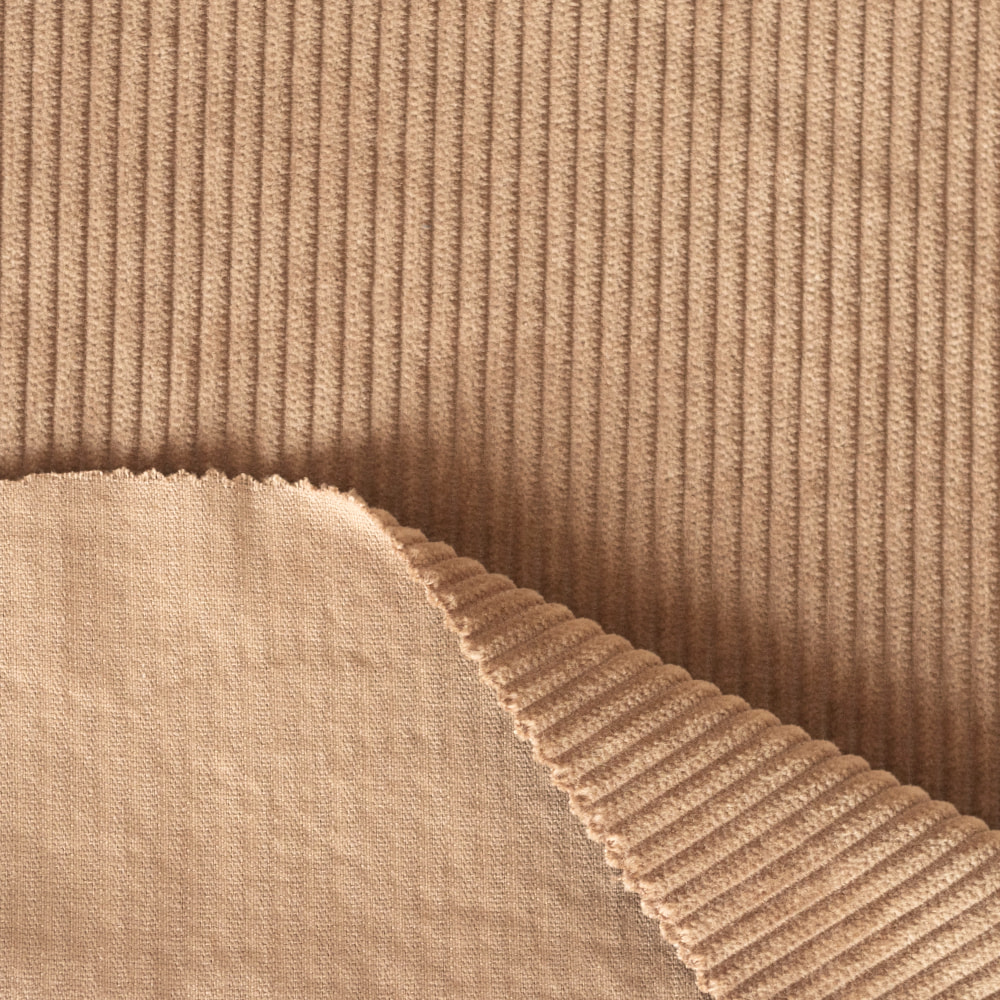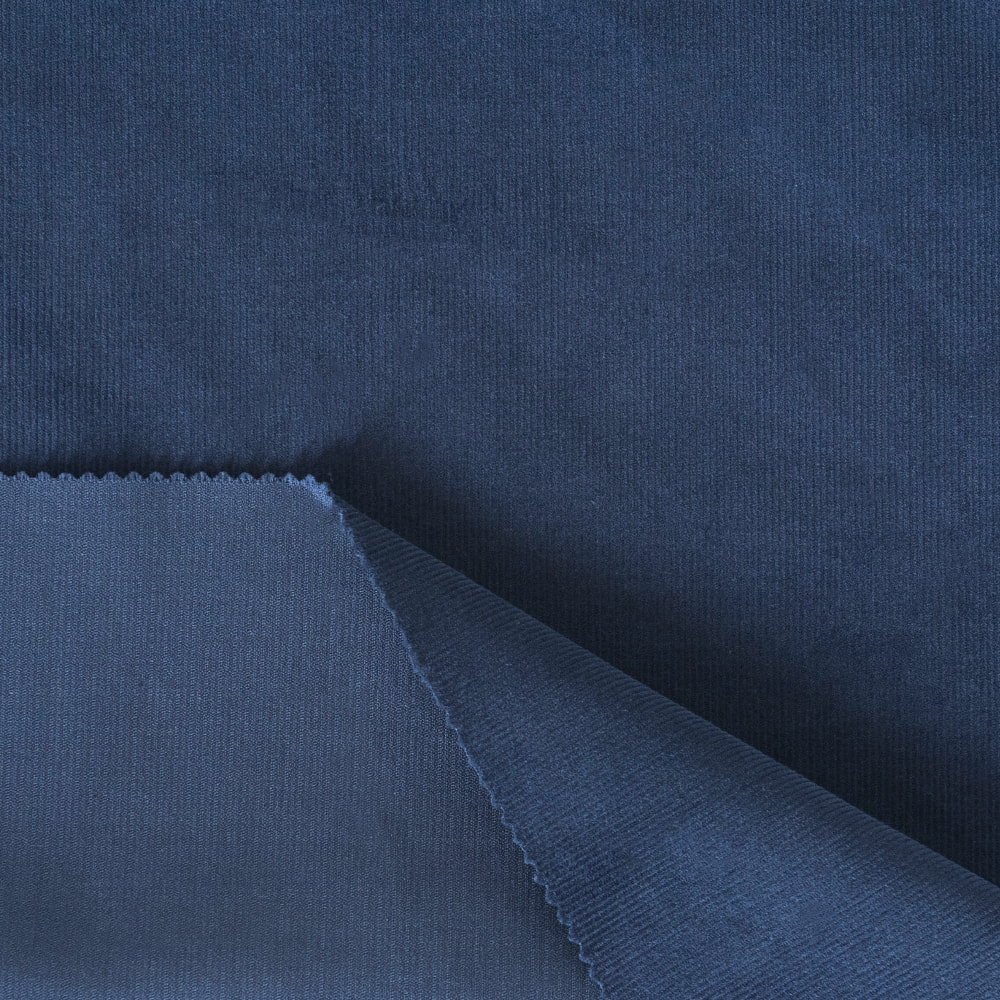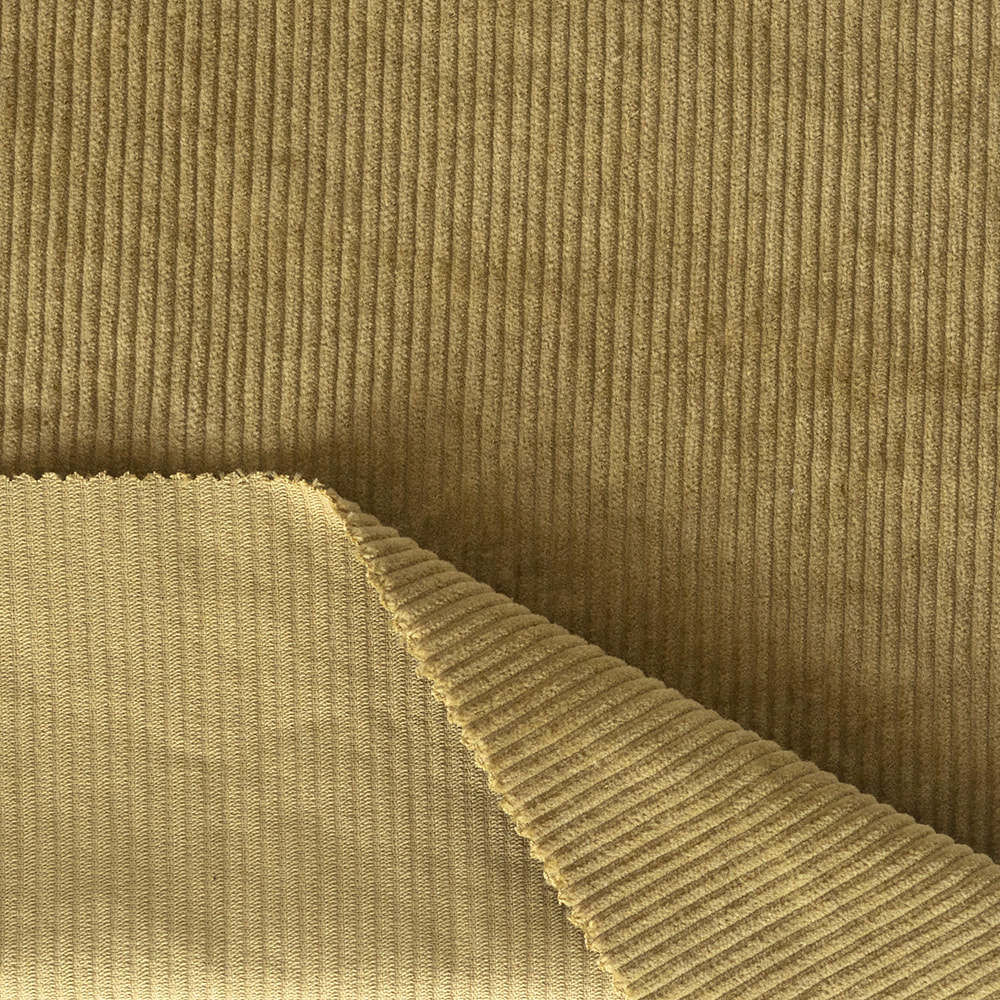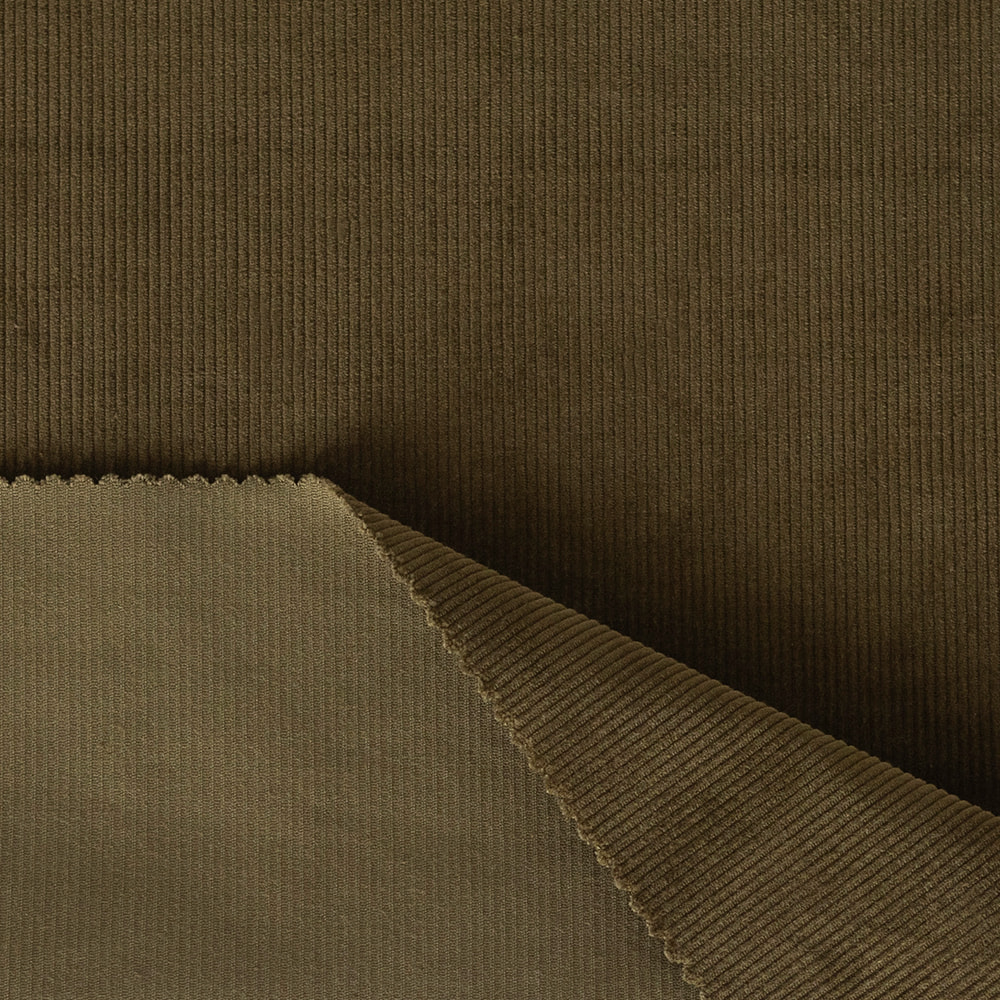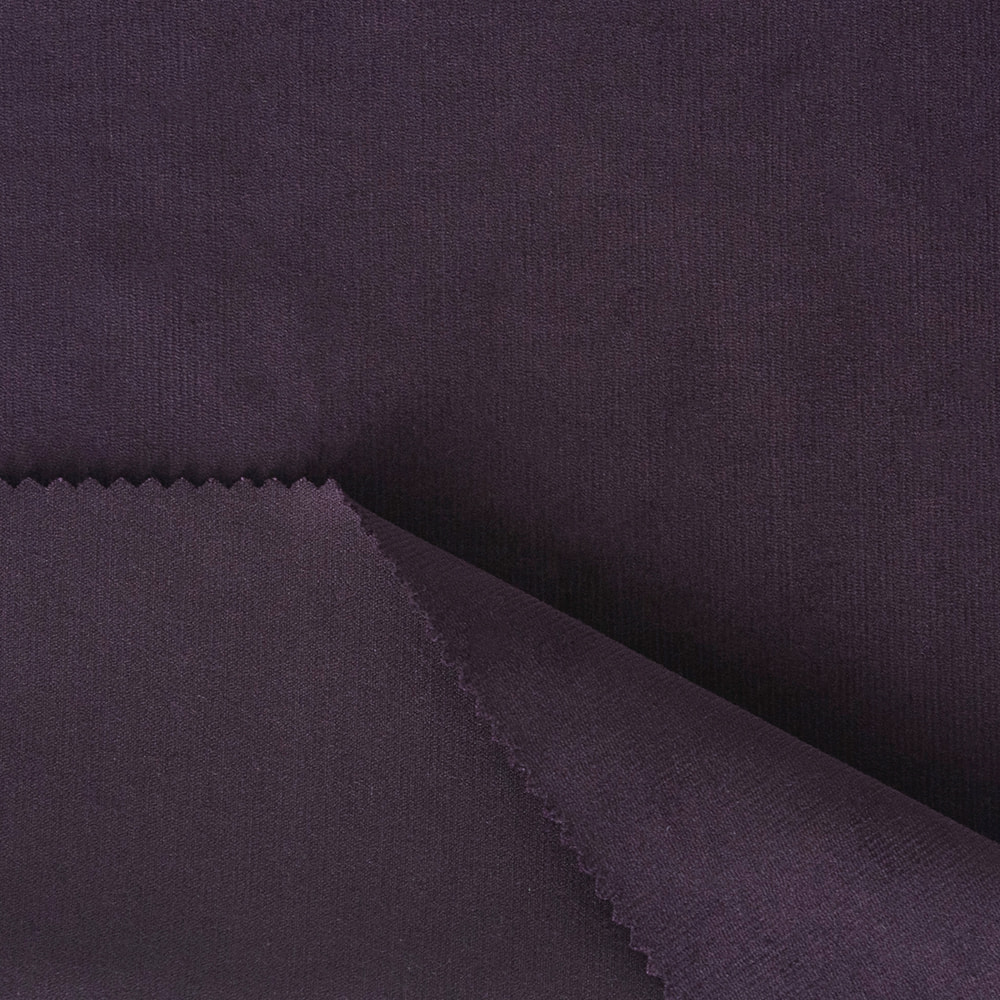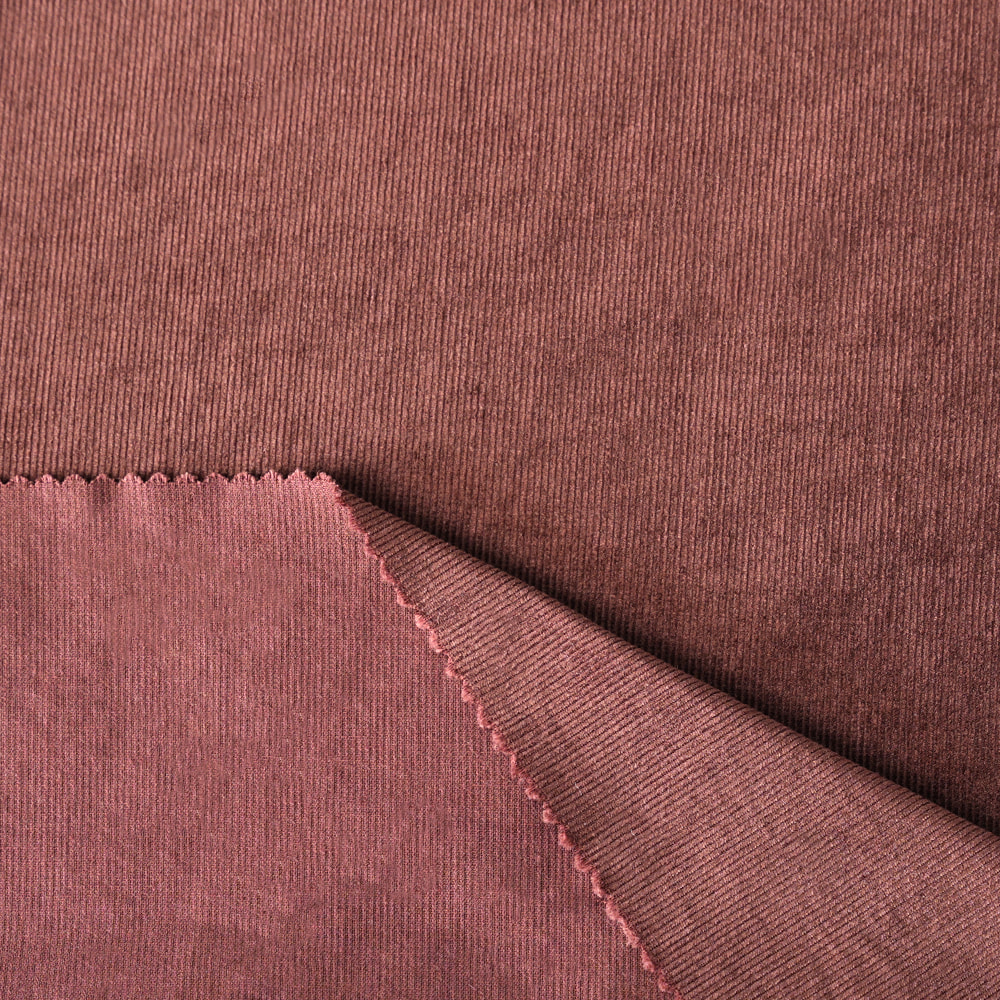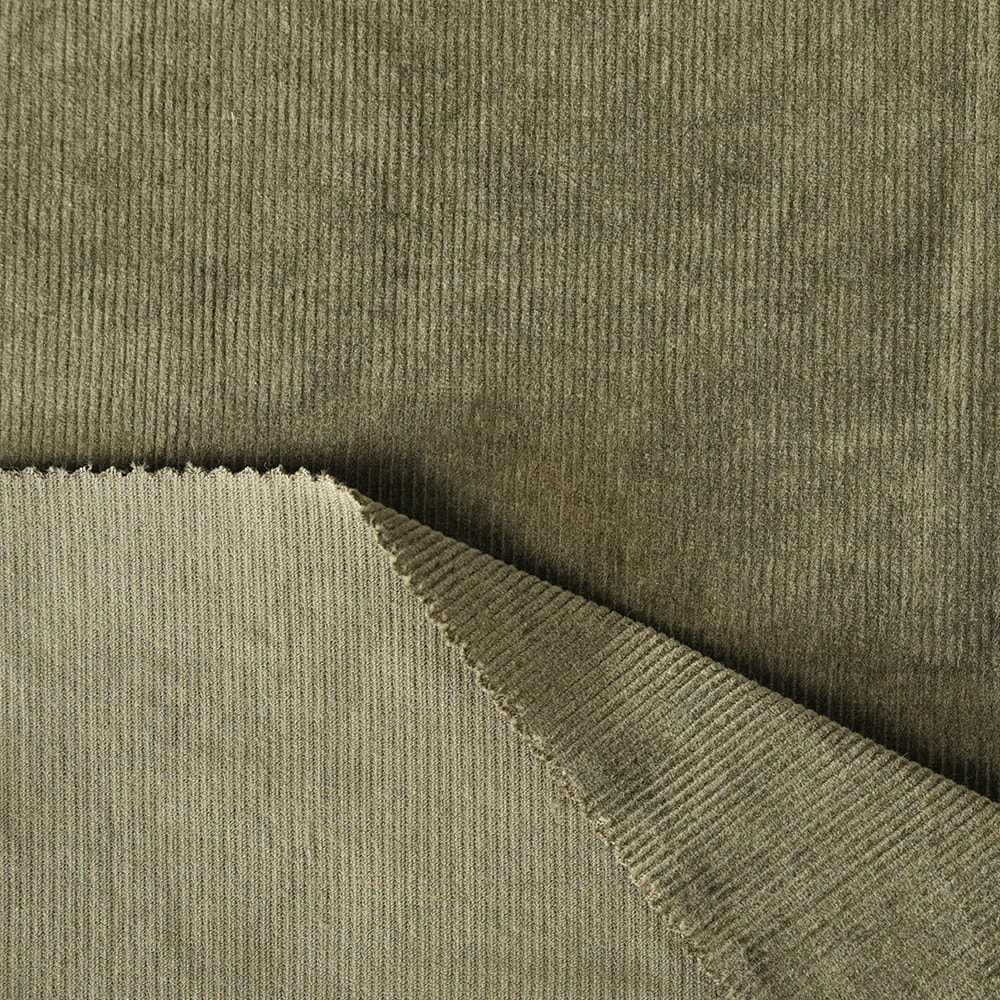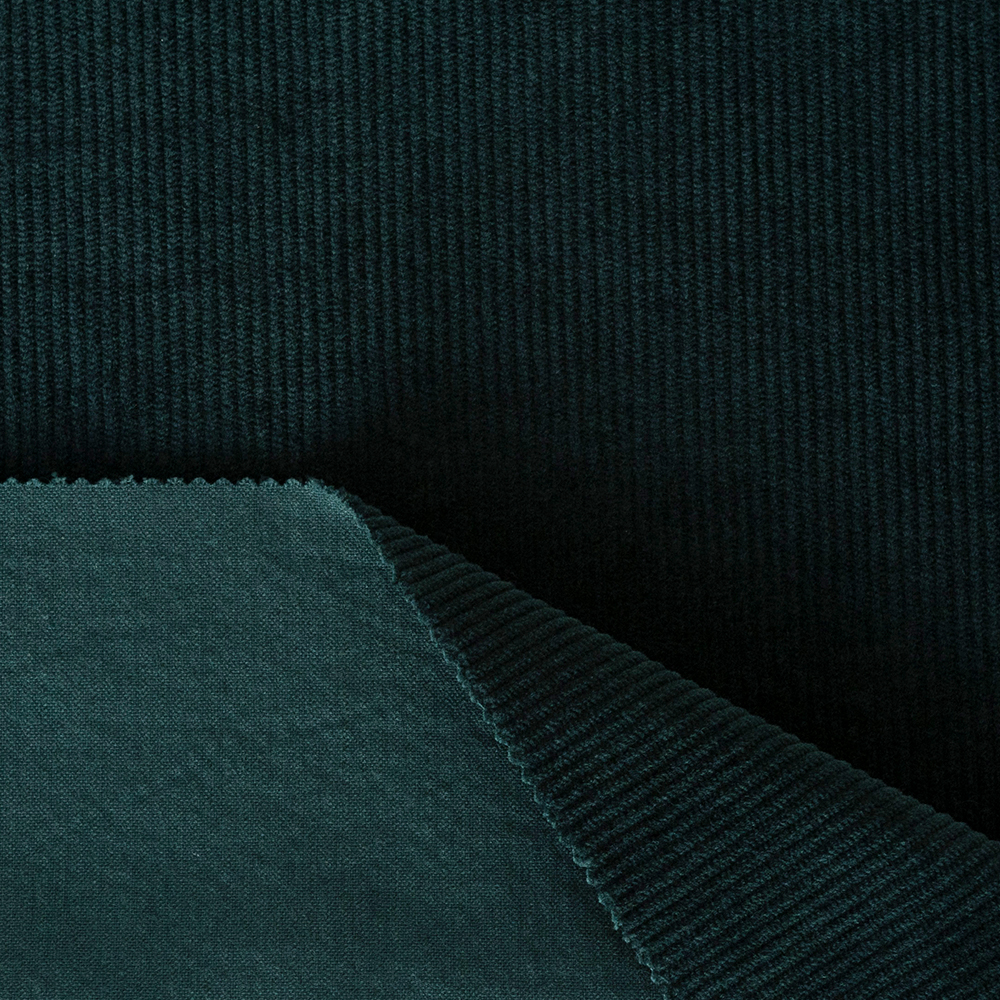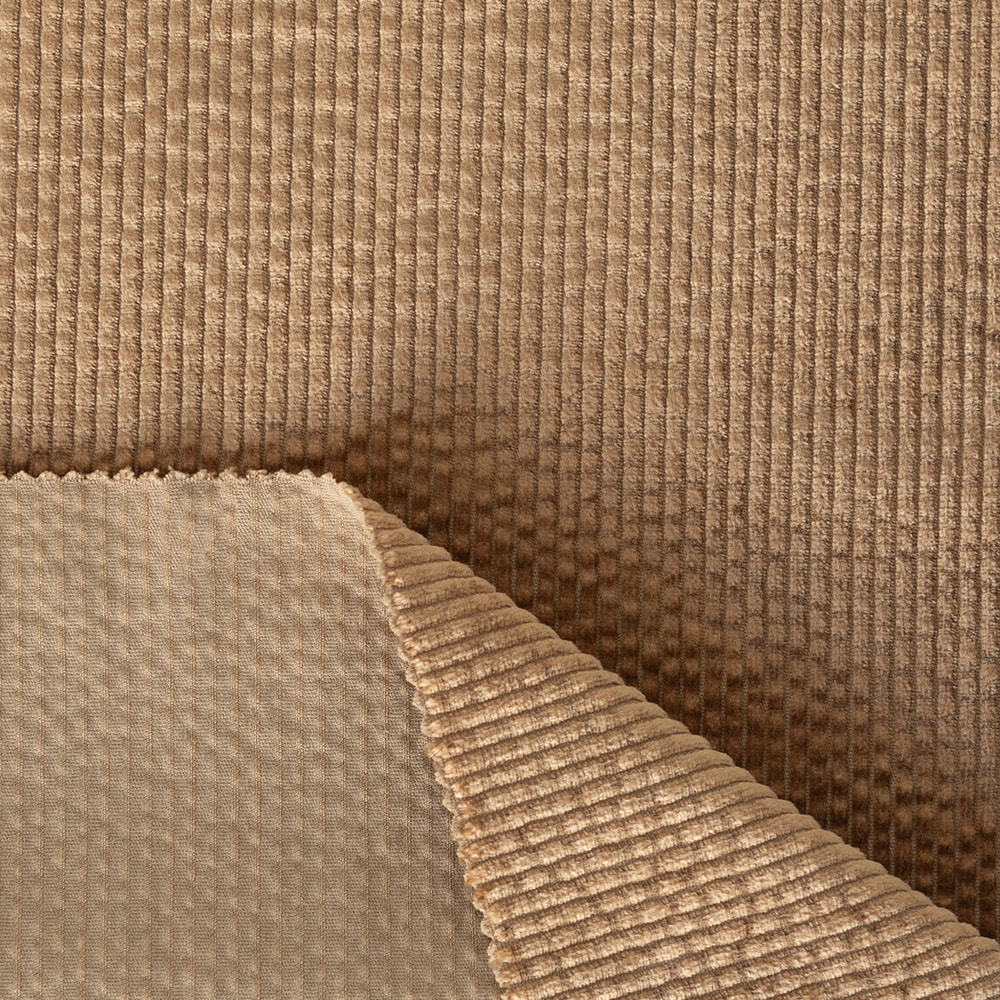Textile Industry Zone, East Hutang Town, Wujin District,213100 Changzhou,China
Understanding the Fabric: What is Rayon-Cotton Piece-Dyed Corduroy?
To fully appreciate this fabric, it’s essential to break down its name into its core components: rayon-cotton, corduroy, and piece-dyed.
Rayon-Cotton Blend
Rayon-cotton fabric is a blend of two fibers: rayon and cotton. Rayon is a semi-synthetic fiber made from regenerated cellulose derived from wood pulp or other plant materials. It is known for its soft texture, excellent drape, and silk-like sheen, which lends an elegant touch to fabrics made from it. Rayon is highly absorbent and breathable, making it comfortable in various climates.
Cotton, on the other hand, is a natural fiber harvested from cotton plants. It is prized for its durability, breathability, and moisture-wicking abilities. Cotton fabric is soft, strong, and hypoallergenic, widely used in everything from casual wear to high-end textiles.
When these two fibers are blended, the resulting fabric benefits from the best attributes of each: the softness and sheen of rayon combined with the strength and comfort of cotton. This blend often results in a fabric that is both pleasant to touch and durable enough for daily wear.
Corduroy Texture
Corduroy is a type of woven fabric distinguished by its raised parallel ridges or "wales" running vertically along the fabric surface. These ribs are formed by extra sets of yarn woven into the base fabric, creating a unique texture that is soft, warm, and visually rich. Historically, corduroy became popular for its durability and warmth, making it a favorite in workwear and casual clothing.
The number of wales per inch can vary, affecting the fabric's appearance and feel—from fine wale corduroy, which looks almost smooth and delicate, to wide wale corduroy, which is chunkier and more rugged. The ribbed texture adds a three-dimensional quality to the fabric, enhancing its tactile appeal.
Piece-Dyed Process
Piece-dyeing refers to a dyeing technique where the fabric is dyed after weaving, as opposed to dyeing the yarns before weaving (yarn-dyeing) or dyeing finished garments (garment-dyeing). This method allows for excellent color uniformity and fastness because the entire fabric piece is immersed in the dye bath, ensuring even absorption of color throughout.
In the context of rayon-cotton corduroy, piece-dyeing helps unify the coloration of the two different fibers. Since rayon and cotton have different dye affinities, this process carefully balances the color uptake, resulting in rich, vibrant hues that maintain their appearance even after repeated washing.
Historical and Industry Context
Corduroy fabrics date back centuries, originally developed as a durable textile for laborers and outdoor workers due to their toughness and insulation properties. Over time, corduroy transcended its utilitarian roots to become a fashionable fabric embraced by designers worldwide.
With the introduction of fiber blending and innovative dyeing methods, corduroy fabrics evolved further. The addition of rayon to cotton blends brought new life to traditional corduroy, offering enhanced softness and sheen without sacrificing durability.
Piece-dyeing, as a technique, became popular in the 20th century due to its efficiency and ability to produce large volumes of fabric with consistent colors. This dyeing method suits fabrics intended for mass production while maintaining a high-quality finish.
Together, these advancements positioned rayon-cotton piece-dyed corduroy as a modern fabric that bridges tradition and innovation, offering designers a material that meets contemporary needs.
Key Characteristics of Rayon-Cotton Piece-Dyed Corduroy
Comfort and Wearability
One of the primary reasons for the popularity of rayon-cotton corduroy is its comfort. Cotton's breathability helps regulate temperature and wick moisture away from the body, while rayon's smooth fibers provide softness and a gentle hand feel. The ribbed texture of corduroy adds an element of warmth without heaviness, making this fabric suitable for multiple seasons.
Aesthetic Appeal
The fabric’s texture and the piece-dyeing process combine to create a visually appealing surface. The raised wales catch light differently than the base fabric, offering depth and dimension. Piece-dyeing enhances this by delivering vibrant, uniform colors that highlight the fabric's texture.
The interplay between rayon’s natural sheen and cotton’s matte finish results in a fabric with subtle visual complexity, making it attractive for casual and upscale clothing alike.
Durability and Maintenance
Blending cotton with rayon improves the fabric’s durability compared to pure rayon, which can be weaker. Corduroy’s woven rib structure also provides strength, resisting wear and tear better than plain woven fabrics.
Piece-dyed corduroy fabrics maintain color stability better than some other dyeing techniques, reducing fading over time. This durability makes the fabric a practical choice for everyday garments and home furnishings.
Why is Rayon-Cotton Piece-Dyed Corduroy Fabric Important Today?
Versatility
This fabric suits a broad range of applications from fashion apparel like jackets, trousers, and skirts to home textiles such as cushions and upholstery. Its ability to balance softness with durability and aesthetic richness makes it a go-to fabric for designers and manufacturers.
Sustainability Considerations
Both cotton and rayon have environmental considerations. Cotton is renewable but requires significant water and pesticide use unless organic. Rayon is derived from natural cellulose but involves chemical processing. Recent advancements focus on sustainable production, including organic cotton and eco-friendly rayon variants, improving the fabric’s environmental footprint.
Consumer Trends
Modern consumers seek fabrics that combine comfort, style, and durability. Rayon-cotton piece-dyed corduroy aligns with this demand by offering a unique tactile experience and appearance, suitable for casual wear, workwear, and fashion-forward designs. The fabric’s warmth and texture also appeal to consumers seeking seasonal versatility.
Rayon-cotton piece-dyed corduroy fabric represents a fusion of traditional textile craftsmanship and modern material science. Its blend of fibers, unique ribbed texture, and sophisticated dyeing process deliver a fabric that excels in comfort, appearance, and performance. Whether used in clothing or home décor, this fabric continues to meet the evolving demands of designers and consumers, making it a significant player in the contemporary textile landscape.
Composition and Structure of Rayon-Cotton Piece-Dyed Corduroy Fabric
Understanding the composition and structural properties of rayon-cotton piece-dyed corduroy fabric is essential to grasp why this material is so valued in the textile industry. This section breaks down the fiber blend, the unique corduroy weave, and the piece-dyeing process that together define the fabric’s distinctive qualities.
1. Material Components
1.1 Rayon: The Semi-Synthetic Fiber
Rayon, also known as viscose, is a versatile fiber created from regenerated cellulose extracted from natural sources such as wood pulp or bamboo. It is considered semi-synthetic because it undergoes extensive chemical processing to convert raw cellulose into fiber.
Rayon fibers possess several notable properties:
Softness and Smoothness: Rayon has a silky texture and excellent drape, lending garments an elegant flow and gentle hand feel.
Breathability: Rayon fibers absorb moisture well and release it quickly, making fabrics comfortable for warm and humid climates.
Lustrous Appearance: Rayon’s inherent sheen enhances the aesthetic appeal of fabrics.
Dye Affinity: Rayon readily absorbs dyes, allowing for bright, rich colors.
However, rayon can be weaker when wet and may wrinkle easily, which is why blending it with cotton improves its overall performance in textiles.
1.2 Cotton: The Natural Fiber
Cotton is one of the most widely used natural fibers globally. It is composed of cellulose, harvested from cotton plant seeds, and is cherished for its:
Durability and Strength: Cotton fibers provide structural integrity, making fabrics more resistant to wear and tear.
Breathability and Moisture Management: Cotton efficiently absorbs sweat and allows air circulation, enhancing wearer comfort.
Hypoallergenic Nature: Cotton is gentle on sensitive skin and less likely to cause irritation.
Easy Care: Cotton fabrics are generally easy to wash and maintain.
By itself, cotton can sometimes lack the drape and sheen found in rayon. Blending these two fibers combines their advantages while mitigating their individual limitations.
1.3 The Blend Ratio and Its Effects
The proportion of rayon and cotton in the blend significantly influences the fabric’s characteristics. Typical blend ratios range from:
40% Rayon / 60% Cotton: Results in a fabric that favors durability and breathability while retaining some of rayon’s softness and sheen.
50% Rayon / 50% Cotton: Offers a balanced feel with a moderate drape, softness, and strength.
60% Rayon / 40% Cotton: Produces a softer, more lustrous fabric but slightly less durable.
Choosing the optimal blend depends on the intended application and desired performance. For example, apparel needing frequent washing and heavy wear might use a higher cotton content, while fashion pieces emphasizing softness and sheen might use more rayon.
2. Corduroy Fabric Structure
2.1 What Makes Corduroy Unique?
Corduroy is a woven textile distinguished by its raised vertical ribs, or “wales,” that run parallel along the fabric. These wales are created by extra sets of filling or pile yarns woven into the base cloth, which are then cut or raised to create a soft pile.
This structure gives corduroy several unique qualities:
Textural Interest: The ridges add a three-dimensional tactile and visual element.
Durability: The extra pile yarns contribute to fabric thickness and resistance to abrasion.
Warmth: The pile traps air, providing insulation that makes corduroy a popular choice for cooler weather garments.
2.2 Understanding Wale Count
Corduroy fabrics vary based on the number of wales per inch, a measure of how closely the ribs are spaced:
Wide Wale Corduroy: 1-8 wales per inch. These have thick, pronounced ribs that give a chunky, bold look.
Medium Wale Corduroy: 9-12 wales per inch. These offer a balanced texture, suitable for a variety of garments.
Fine Wale Corduroy: 13+ wales per inch. These have closely spaced, thin ribs, resulting in a smoother, more delicate surface.
The wale count influences the fabric’s weight, texture, and aesthetic, allowing manufacturers to tailor the fabric to specific design requirements.
2.3 Corduroy Weaving Process
The weaving process for corduroy is more complex than for plain fabrics. It involves:
Base Fabric Formation: A standard woven fabric is created using warp and weft yarns.
Insertion of Extra Pile Yarns: Additional yarns are woven into the base fabric in a way that allows them to be lifted or cut to form the raised ribs.
Cutting or Raising the Pile: The loops formed by pile yarns are either cut (cut pile) or left intact (uncut pile), with cut pile corduroy being the most common.
Shearing and Finishing: The pile is sheared to an even height and finished with treatments to enhance softness and durability.
This meticulous weaving process contributes to corduroy’s distinctive appearance and functional qualities.
3. Piece-Dyeing Technique
3.1 Definition of Piece-Dyeing
Piece-dyeing refers to a fabric-level dyeing process where the entire woven fabric (the “piece”) is dyed after it has been woven, rather than dyeing yarns before weaving or dyeing finished garments.
This technique contrasts with:
Yarn-dyeing: Dyeing the yarns before they are woven.
Garment-dyeing: Dyeing the finished clothing item.
3.2 Advantages of Piece-Dyeing
Piece-dyeing offers several benefits:
Uniform Color Penetration: Dye penetrates evenly through the fabric, resulting in consistent coloration.
Versatility: It allows manufacturers to produce large quantities of undyed fabric first and dye it later according to demand.
Cost Efficiency: It is less labor-intensive compared to yarn-dyeing, reducing production costs.
Colorfastness: Fabrics dyed this way typically maintain their color integrity well, especially when quality dyes and processes are used.
3.3 Challenges in Dyeing Rayon-Cotton Blends
Rayon and cotton fibers differ in their chemical structures and dye affinities:
Rayon absorbs dyes quickly but can be prone to color fading if not treated properly.
Cotton requires different dye types and longer dyeing cycles to achieve deep color penetration.
Piece-dyeing blends these two fibers at the fabric stage, demanding careful control of dye bath formulations, temperature, and timing to ensure balanced coloration. Specialized dyeing recipes are developed to harmonize the color uptake, preventing issues such as color bleeding or unevenness.
3.4 Impact on Fabric Appearance and Performance
The piece-dyeing process enhances the aesthetic appeal of rayon-cotton corduroy fabric by:
Producing deep, saturated colors that emphasize the texture of the wales.
Enabling subtle variations in shading, giving the fabric a rich, dimensional look.
Improving colorfastness, so the fabric resists fading even after multiple washes.
4. The Synergy of Components: How Composition and Structure Work Together
The interplay of fiber composition, corduroy weaving, and piece-dyeing results in a fabric that is more than the sum of its parts. Rayon’s softness complements cotton’s strength, while the corduroy ribs add a tactile warmth and durability. Piece-dyeing ensures the final fabric is visually stunning with consistent, lasting color.
This synergy makes rayon-cotton piece-dyed corduroy fabric ideal for a variety of applications—from stylish apparel requiring softness and sheen to durable home textiles needing texture and longevity.
Summary
Fiber Blend: Rayon and cotton combined balance softness, strength, breathability, and sheen.
Corduroy Texture: Vertical ribs formed by extra pile yarns provide warmth, durability, and visual depth.
Piece-Dyeing: Dyeing the woven fabric after weaving delivers rich, uniform colors and enhanced colorfastness.
Fabric Properties: The resulting fabric is soft, comfortable, durable, warm, and visually appealing.
Production Process of Rayon-Cotton Piece-Dyed Corduroy Fabric
The production of rayon-cotton piece-dyed corduroy fabric is a complex journey that transforms raw fibers into a richly textured, vibrant fabric. This process combines advanced fiber processing, specialized weaving techniques, and precise dyeing methods to ensure the fabric meets high standards of quality, performance, and aesthetics. In this section, we will explore each step of the production process in detail, highlighting the techniques and technology involved.
1. Fiber Preparation and Blending
1.1 Selection of Raw Fibers
The production begins with sourcing high-quality rayon and cotton fibers. The quality of these fibers significantly influences the final fabric’s properties. Cotton fibers are selected based on length, strength, and cleanliness, while rayon is produced in filament or staple form after chemical processing of cellulose.
1.2 Blending Fibers
Once the fibers are ready, they are blended to the desired ratio (e.g., 50% rayon / 50% cotton). Blending ensures the uniform distribution of both fibers, which is critical for achieving consistent fabric qualities. Blending can be done at the fiber stage, where raw fibers are mixed before spinning, or at the yarn stage, where pre-spun yarns are combined.
This blend helps combine the softness and sheen of rayon with the durability and breathability of cotton.
2. Spinning the Yarn
The blended fibers are then spun into yarns using modern spinning machinery. The spinning process twists and draws the fibers to form yarns of desired thickness and strength.
Ring spinning is often used for higher-quality yarns, providing strength and smoothness.
Open-end spinning can be employed for more cost-effective yarns but may produce rougher textures.
The yarn count and twist level are carefully controlled to suit the requirements of corduroy weaving, ensuring the yarns can withstand the tension and abrasion during weaving and pile formation.
3. Weaving the Base Fabric and Pile Formation
3.1 Weaving the Base Cloth
Corduroy is essentially a cut-pile woven fabric, so its production starts with creating a strong woven base cloth. This base cloth is usually a plain or twill weave of warp and weft yarns, providing the structural foundation.
3.2 Insertion of Extra Pile Yarns
The defining feature of corduroy is the vertical ribs or wales, created by extra sets of pile yarns. These pile yarns are woven into the base fabric in a way that they form loops standing above the base surface.
3.3 Cutting the Pile
After weaving, the loops formed by pile yarns are cut open to create the characteristic soft, raised ribs. This is done using specialized cutting machines that carefully slice through the loops without damaging the fabric.
3.4 Shearing and Finishing
The pile is then sheared to an even height, usually ranging from 1 to 4 millimeters, depending on the wale count and desired fabric thickness. Shearing gives the fabric a uniform texture and a smooth hand feel.
After shearing, the fabric undergoes mechanical finishing processes such as:
Brushing: Enhances softness by lifting fibers on the pile surface.
Sanforizing: Pre-shrinks the fabric to prevent distortion during later washing.
Calendering: Passes fabric through rollers to flatten and give a polished surface if desired.
4. Piece-Dyeing Process
4.1 Preparing the Fabric for Dyeing
Before dyeing, the corduroy fabric must be thoroughly cleaned to remove any impurities, oils, or sizing agents from weaving. This step, called scouring, ensures even dye uptake.
4.2 Immersion Dyeing
In piece-dyeing, the entire fabric is immersed in dye baths containing carefully selected dyes suited for the rayon-cotton blend. Reactive dyes or vat dyes are commonly used because they form strong chemical bonds with cellulose fibers, improving colorfastness.
Dyeing parameters such as temperature, pH, and time are meticulously controlled to balance the different dye absorption rates of rayon and cotton.
4.3 Rinsing and Washing
After dyeing, the fabric is rinsed multiple times to remove unfixed dyes and chemicals. Proper rinsing prevents color bleeding and ensures the fabric meets quality standards for safety and appearance.
4.4 Post-Dyeing Finishes
Additional finishing treatments may be applied to enhance the fabric’s feel, durability, or functional properties, such as:
Softening agents to improve hand feel.
Anti-pilling finishes to reduce surface fuzzing.
Water-repellent or stain-resistant coatings depending on the end use.
5. Quality Control and Inspection
Throughout the production process, the fabric undergoes rigorous quality control checks to ensure it meets technical and aesthetic specifications.
Yarn quality tests: Measure strength, twist, and uniformity.
Weaving inspections: Check for defects such as missed ribs or broken yarns.
Pile height and uniformity checks: Ensure consistent rib height.
Color fastness tests: Assess resistance to washing, rubbing, and light exposure.
Dimensional stability: Verify shrinkage rates after finishing.
Any fabric failing to meet standards is either reprocessed or rejected, ensuring only premium-quality textile reaches the market.
6. Cutting and Garment Manufacturing
After production, the finished rayon-cotton piece-dyed corduroy fabric is supplied to garment manufacturers or home textile producers. Its:
Soft hand feel and warm texture make it ideal for fall and winter apparel like jackets, pants, and skirts.
Durability and vibrant colors lend well to upholstery, cushions, and decorative textiles.
Manufacturers cut and sew the fabric into final products, which then go through additional processes such as washing, pressing, and labeling before reaching consumers.
Summary of Production Steps
| Step | Description |
| Fiber Blending | Mixing rayon and cotton fibers at fiber or yarn stage |
| Yarn Spinning | Creating durable yarns suitable for corduroy weaving |
| Base Fabric Weaving | Weaving warp and weft yarns into a strong base cloth |
| Pile Yarn Insertion | Weaving extra yarns to form pile loops |
| Pile Cutting and Shearing | Cutting loops to form ribs, shearing to uniform height |
| Mechanical Finishing | Brushing, sanforizing, calendering for softness and durability |
| Scouring | Cleaning fabric before dyeing |
| Piece-Dyeing | Immersing fabric in dye baths for uniform color |
| Post-Dyeing Finishing | Applying softeners, anti-pilling, or coatings |
| Quality Control | Inspecting yarns, weave, pile, color fastness, and shrinkage |
| Cutting and Garment Making | Transforming fabric into apparel or home textiles |
Technological Innovations in Production
Modern textile manufacturing increasingly incorporates automation and precision machinery to improve efficiency and quality. Computerized looms allow precise control over pile formation and wale count, while advanced dyeing machines maintain tight controls on temperature and chemical composition.
Sustainability is also a growing focus, with manufacturers adopting eco-friendly dyes, water recycling systems, and organic cotton sources to reduce environmental impact.
The production process of rayon-cotton piece-dyed corduroy fabric is a sophisticated sequence of carefully coordinated steps. From fiber selection and blending through spinning, weaving, pile formation, dyeing, finishing, and quality control, each stage is vital to creating a fabric that balances softness, durability, warmth, and visual appeal.
This intricate process ensures the fabric’s unique qualities are preserved and enhanced, meeting the demanding standards of today’s textile and fashion industries. In the following sections, we will discuss the performance characteristics, applications, and market trends that define the success and popularity of rayon-cotton piece-dyed corduroy fabric.
Performance Characteristics and Applications of Rayon-Cotton Piece-Dyed Corduroy Fabric
Rayon-cotton piece-dyed corduroy fabric stands out for its unique blend of fiber qualities, structural properties, and finishing techniques. These factors together define its performance characteristics, making it highly sought-after in various sectors. This section explores the fabric’s physical, aesthetic, and functional attributes in detail and discusses its popular applications across fashion, home textiles, and industrial uses.
1. Key Performance Characteristics
1.1 Softness and Comfort
One of the most notable features of rayon-cotton corduroy is its soft hand feel. Rayon fibers contribute silkiness and smoothness, while cotton adds a natural, breathable texture. The corduroy pile further enhances comfort by providing a plush surface that feels gentle against the skin.
This softness makes the fabric ideal for clothing that stays comfortable during prolonged wear. Unlike synthetic materials that can feel stiff or clammy, rayon-cotton corduroy breathes well and adjusts to body temperature, preventing overheating or excessive sweating.
1.2 Durability and Strength
Cotton’s natural strength combined with the robustness of the corduroy weave results in a fabric that is durable and wear-resistant. The dense pile yarns protect the base fabric from abrasion and friction, prolonging garment life.
This durability makes rayon-cotton corduroy suitable for casual and workwear clothing items that require frequent washing and rough use. The fabric resists pilling and maintains its textured appearance even after multiple cleaning cycles.
1.3 Warmth and Insulation
Corduroy’s characteristic raised ribs create air pockets that trap warmth, giving the fabric excellent insulating properties. This thermal retention makes it a preferred choice for cooler seasons and climates.
The rayon-cotton blend also helps regulate moisture, wicking sweat away while keeping the wearer warm, which enhances comfort in variable conditions.
1.4 Aesthetic Appeal
The piece-dyeing process imbues the fabric with rich, uniform colors that highlight the texture and depth of the wales. The subtle sheen of rayon adds a luminous quality to the surface, making the fabric visually attractive.
The wale structure also creates light and shadow effects, giving garments or textiles a multidimensional look that stands out from flat, plain fabrics. This distinctive appearance adds sophistication and uniqueness to fashion and home décor.
1.5 Easy Care and Maintenance
Rayon-cotton corduroy is relatively easy to care for. The cotton content allows for machine washing, while the finishing treatments applied during production (such as sanforizing and anti-pilling finishes) minimize shrinkage and surface fuzz.
However, because rayon can weaken when wet, it is recommended to wash these fabrics in gentle cycles and avoid excessive heat drying to maintain longevity.
2. Applications in Apparel
2.1 Casual and Everyday Wear
Rayon-cotton piece-dyed corduroy fabric is widely used in casual apparel such as trousers, jackets, skirts, and shirts. Its softness, warmth, and durability make it perfect for:
Fall and winter clothing where insulation and comfort are essential.
Relaxed styles that benefit from the fabric’s drape and texture.
Layering pieces that provide both visual interest and thermal regulation.
The fabric’s ability to hold vibrant colors through piece-dyeing allows designers to experiment with a broad color palette, from earthy tones to bright hues, making it versatile for various fashion trends.
2.2 Workwear and Uniforms
The durability and comfort of rayon-cotton corduroy also suit it for workwear and uniforms. The fabric withstands frequent washing and wear while maintaining a professional appearance. Additionally, the textured surface masks minor stains and signs of wear, extending garment life.
Industries such as hospitality, education, and light manufacturing may select corduroy garments for staff uniforms, balancing practicality and style.
2.3 Children’s Clothing
Thanks to its softness and hypoallergenic properties, rayon-cotton corduroy is favored for children’s apparel. It offers warmth and comfort while being durable enough to endure active use. The fabric’s easy-care features are also a plus for parents managing frequent laundry.
3. Home Textile Applications
3.1 Upholstery and Furniture Covers
Corduroy’s durability and textured appearance make it an excellent choice for upholstery fabrics. Rayon-cotton blends add softness that enhances comfort on furniture pieces like sofas, chairs, and cushions.
The piece-dyed colors help maintain a fresh, vibrant look in home décor, and the pile structure adds visual depth and warmth to interior spaces.
3.2 Curtains and Drapery
Though less common than upholstery, corduroy is sometimes used in curtains and drapery, especially in rooms requiring insulation. The fabric’s thickness and texture help block drafts and absorb sound, contributing to energy efficiency and acoustic comfort.
The rich colors from piece-dyeing can also complement various interior design styles, from rustic to contemporary.
3.3 Decorative Accessories
Rayon-cotton corduroy is also employed in smaller home textile items such as throw pillows, cushion covers, and bed runners. These accents benefit from the fabric’s soft texture and attractive appearance, providing tactile and visual interest.
4. Industrial and Technical Uses
Although primarily a fashion and home textile fabric, rayon-cotton piece-dyed corduroy finds occasional use in specialized industrial applications where soft, durable textiles are needed. For example:
Protective clothing layers requiring thermal insulation.
Automotive interiors where fabric softness and durability are important.
Crafts and upholstery restoration projects.
The fabric’s combination of aesthetics and functional qualities allows it to meet specific technical needs beyond everyday apparel and décor.
5. Market Trends and Consumer Preferences
5.1 Sustainability Considerations
As consumers become more environmentally conscious, the textile industry is seeing a growing demand for sustainable fabrics. Rayon-cotton blends appeal due to their natural and regenerated cellulose origins, but environmental concerns about rayon production processes persist.
Manufacturers are responding by sourcing eco-friendly rayon (e.g., lyocell) and organic cotton, employing water-efficient dyeing technologies, and recycling production waste to minimize environmental impact.
5.2 Fashion Trends Favoring Corduroy
Corduroy has experienced a resurgence in recent years, embraced by designers for its nostalgic yet contemporary appeal. The textured, tactile nature of corduroy fits well with trends toward comfort wear, vintage-inspired fashion, and tactile fabrics.
Piece-dyed rayon-cotton corduroy, with its vibrant color options and luxurious feel, is positioned well to capitalize on these trends.
5.3 Versatility and Customization
The ability to customize wale count, fiber blend ratios, and dye colors offers brands and designers great versatility. This adaptability allows the fabric to cater to diverse markets, from premium fashion labels to mass-market casual wear and home furnishings.
6. Challenges and Considerations
Despite many strengths, rayon-cotton piece-dyed corduroy fabric also presents some challenges:
Care Sensitivity: Rayon’s weaker wet strength requires gentle washing to avoid damage.
Cost: The fabric may be more expensive than pure cotton corduroy due to fiber blending and dyeing complexity.
Environmental Impact: The chemical processing of rayon can raise sustainability concerns, necessitating responsible sourcing and manufacturing practices.
Balancing these factors with the fabric’s benefits is crucial for producers and consumers alike.
Summary
Rayon-cotton piece-dyed corduroy fabric offers a unique combination of:
Softness and warmth ideal for comfortable, stylish apparel.
Durability and strength suitable for long-lasting garments and home textiles.
Visual richness from the pile texture and vibrant piece-dyed colors.
Versatility across fashion, home décor, and some technical applications.
Its performance characteristics align well with modern consumer demands for comfort, style, and quality, while its production processes continue evolving toward greater sustainability.
Market Trends, Care Tips, and Comparisons of Rayon-Cotton Piece-Dyed Corduroy Fabric
Understanding the commercial landscape, practical maintenance, and comparative advantages of rayon-cotton piece-dyed corduroy fabric is essential for manufacturers, retailers, designers, and consumers alike. This section will explore the current market dynamics, provide comprehensive care guidelines, and compare this fabric to similar textile options to highlight its unique value.
1. Market Trends
1.1 Growing Demand for Textured and Comfortable Fabrics
In recent years, there has been a noticeable shift in consumer preferences toward comfort-oriented and textured fabrics, especially in casual and athleisure wear. The tactile appeal of corduroy, combined with the softness of rayon and breathability of cotton, fits perfectly into this trend. As a result, rayon-cotton piece-dyed corduroy has seen increasing adoption in:
Fall and winter fashion collections.
Casual and workwear segments.
Home textiles focusing on cozy, inviting interiors.
The fabric’s ability to be dyed in rich, deep colors adds to its appeal, enabling designers to meet the demand for both classic and bold, contemporary looks.
1.2 Sustainability and Ethical Production
Sustainability is a major driver in the textile market, influencing sourcing, manufacturing, and marketing. While rayon production traditionally involved chemically intensive processes, advancements in lyocell technology and closed-loop production methods have improved environmental profiles.
Producers are increasingly emphasizing:
Use of organic cotton in blends.
Adoption of low-impact dyes and water-saving dyeing techniques.
Transparent supply chains ensuring ethical labor practices.
Rayon-cotton piece-dyed corduroy fabrics produced under these criteria appeal to eco-conscious consumers and brands.
1.3 Regional Market Variations
North America and Europe: Demand is driven by fashion brands embracing retro and sustainable styles. Home décor also sees steady interest.
Asia-Pacific: Rapid urbanization and rising middle-class incomes fuel growth in casual and workwear segments.
Latin America and Middle East: Emerging markets show growing interest but focus more on affordability, driving demand for blends with higher cotton content.
2. Care Tips for Rayon-Cotton Piece-Dyed Corduroy Fabric
Proper care ensures the fabric maintains its softness, color vibrancy, and structural integrity over time. Here are some practical guidelines:
2.1 Washing Instructions
Machine Wash: Use gentle cycles with cold or lukewarm water to protect rayon fibers.
Hand Wash: For delicate items, hand washing with mild detergent is recommended.
Detergents: Avoid bleach or harsh chemicals; use mild, color-safe detergents.
Separate Colors: Wash similar colors together to prevent bleeding.
2.2 Drying and Ironing
Air Dry: Lay flat or hang to dry; avoid direct sunlight to prevent fading.
Tumble Dry: If necessary, use low heat and remove promptly to reduce wrinkles.
Ironing: Use a medium temperature setting; iron on the reverse side or use a pressing cloth to protect the pile texture.
2.3 Storage Recommendations
Store folded or hung in a cool, dry place.
Avoid heavy stacking to prevent crushing the pile.
Use breathable garment bags for long-term storage.
2.4 Stain Removal
Treat stains promptly with gentle stain removers.
Avoid vigorous rubbing, which can damage the pile.
Test cleaning products on an inconspicuous area first.
3. Comparisons with Other Fabrics
To understand the unique position of rayon-cotton piece-dyed corduroy, it’s useful to compare it to other popular fabrics:
3.1 Rayon-Cotton Corduroy vs. Pure Cotton Corduroy
| Aspect | Rayon-Cotton Corduroy | Pure Cotton Corduroy |
| Softness | Smoother and silkier due to rayon content | Slightly coarser, more matte texture |
| Drape | Better drape and fluidity | Stiffer, more structured |
| Color Vibrancy | Enhanced sheen and richer dye absorption | More muted colors, less sheen |
| Durability | Good, but rayon may weaken wet strength | Generally stronger and more durable |
| Breathability | High, due to cotton and rayon blend | High, but may feel heavier |
| Care Requirements | Requires gentle washing to protect rayon | Easier to care for, more resilient |
3.2 Rayon-Cotton Corduroy vs. Polyester Corduroy
| Aspect | Rayon-Cotton Corduroy | Polyester Corduroy |
| Comfort | Soft, breathable, and warm | Less breathable, can feel synthetic |
| Environmental Impact | Biodegradable fibers, but rayon has chemical concerns | Petroleum-based, less eco-friendly |
| Appearance | Natural luster and warm tones | Can have shiny, artificial look |
| Durability | Good wear resistance | High durability and wrinkle resistance |
| Cost | Moderate to high | Generally lower cost |
3.3 Rayon-Cotton Corduroy vs. Velvet
| Aspect | Rayon-Cotton Corduroy | Velvet |
| Texture | Ribbed, structured surface | Smooth, dense pile with soft sheen |
| Weight | Medium weight | Usually heavier |
| Use Cases | Casual wear, upholstery, versatile | Formal wear, luxury upholstery |
| Care | Easier to maintain | More delicate, requires special care |
4. Future Prospects and Innovations
4.1 Technical Enhancements
Advancements in fiber science and textile engineering continue to refine rayon-cotton corduroy. Future innovations may include:
Incorporation of antimicrobial finishes for enhanced hygiene.
Water-repellent and stain-resistant coatings without compromising softness.
Use of smart textiles for temperature regulation or UV protection.
4.2 Market Expansion through Customization
Manufacturers are exploring ways to customize wale counts, fiber blends, and dye shades more precisely to meet niche market needs, including:
Luxury apparel requiring finer wales and premium blends.
Durable workwear with enhanced abrasion resistance.
Home décor fabrics with specialized finishes.
5. Summary
Rayon-cotton piece-dyed corduroy fabric offers a compelling balance of comfort, style, and performance, supported by:
A growing market driven by fashion trends and sustainability concerns.
Care instructions tailored to preserve fabric qualities.
Unique advantages over other textiles, such as superior softness and color richness.
With ongoing innovations and a diversified market presence, this fabric is well-positioned for continued relevance and growth.
Overall, rayon-cotton piece-dyed corduroy fabric represents a harmonious blend of traditional textile craftsmanship and modern innovation. Its unique combination of texture, comfort, and color vibrancy makes it a preferred choice across fashion and interior design markets. With ongoing advances in sustainable fiber sourcing, dyeing technology, and automated quality control, this fabric is well-positioned for continued growth and relevance in a market increasingly focused on style, performance, and environmental responsibility.
